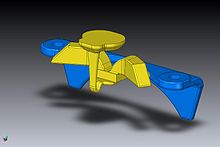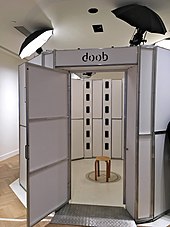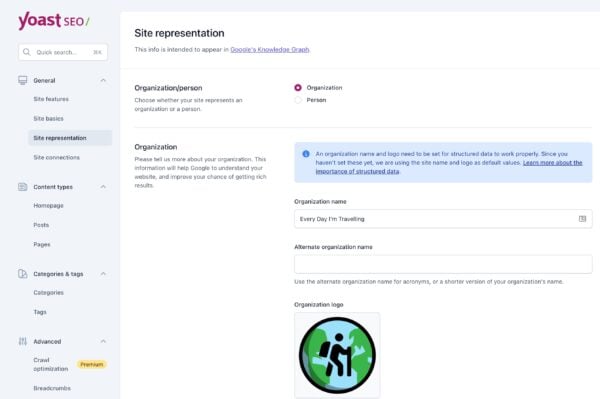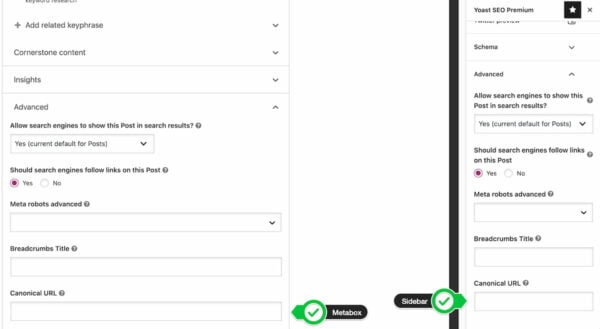A step in the STL generation known as "repair" fixes such problems in the original model.[54][55] Generally STLs that have been produced from a model obtained through 3D scanning often have more of these errors [56] as 3D scanning is often achieved by point to point acquisition/mapping. 3D reconstruction often includes errors.[57]
Once completed, the STL file needs to be processed by a piece of software called a "slicer", which converts the model into a series of thin layers and produces a G-code file containing instructions tailored to a specific type of 3D printer (FDM printers).[58] This G-code file can then be printed with 3D printing client software (which loads the G-code, and uses it to instruct the 3D printer during the 3D printing process).
Printer resolution describes layer thickness and X–Y resolution in dots per inch (dpi) or micrometers (μm). Typical layer thickness is around 100 μm (250 DPI), although some machines can print layers as thin as 16 μm (1,600 DPI).[59] X–Y resolution is comparable to that of laser printers. The particles (3D dots) are around 50 to 100 μm (510 to 250 DPI) in diameter.[citation needed] For that printer resolution, specifying a mesh resolution of 0.01–0.03 mm and a chord length ≤ 0.016 mm generates an optimal STL output file for a given model input file.[60] Specifying higher resolution results in larger files without increase in print quality.
Construction of a model with contemporary methods can take anywhere from several hours to several days, depending on the method used and the size and complexity of the model. Additive systems can typically reduce this time to a few hours, although it varies widely depending on the type of machine used and the size and number of models being produced simultaneously.
Finishing
Though the printer-produced resolution is sufficient for many applications, greater accuracy can be achieved by printing a slightly oversized version of the desired object in standard resolution and then removing material using a higher-resolution subtractive process.[61]
The layered structure of all additive manufacturing processes leads inevitably to a stair-stepping effect on part surfaces which are curved or tilted in respect to the building platform. The effects strongly depend on the orientation of a part surface inside the building process.[62]
Some printable polymers such as ABS, allow the surface finish to be smoothed and improved using chemical vapor processes[63] based on acetone or similar solvents.
Some additive manufacturing techniques are capable of using multiple materials in the course of constructing parts. These techniques are able to print in multiple colors and color combinations simultaneously, and would not necessarily require painting.
Some printing techniques require internal supports to be built for overhanging features during construction. These supports must be mechanically removed or dissolved upon completion of the print.
All of the commercialized metal 3D printers involve cutting the metal component off the metal substrate after deposition. A new process for the GMAW 3D printing allows for substrate surface modifications to remove aluminum[64] or steel.[65]
Materials
Traditionally, 3D printing focused on polymers for printing, due to the ease of manufacturing of manufacturing and handling polymeric materials. However, the method has rapidly evolved to not only print various polymers[67] but also metals[68][69] and ceramics,[70] making 3D printing a versatile option for manufacturing. Layer-by-layer fabrication of three-dimensional physical models is a modern concept that "stems from the ever-growing CAD industry, more specifically the solid modeling side of CAD. Before solid modeling was introduced in the late 1980s, three-dimensional models were created with wire frames and surfaces."[71] but in all cases the layers of materials are controlled by the printer and the material properties. The three-dimensional material layer is controlled by deposition rate as set by the printer operator and stored in a computer file. The earliest printed patented material was a Hot melt type ink for printing patterns using a heated metal alloy. See 1970s history above.
Charles Hull filed the first patent on August 8, 1984, to use a UV-cured acrylic resin using a UV masked light source at UVP Corp to build a simple model. The SLA-1 was the first SL product announced by 3D Systems at Autofact Exposition, Detroit, November 1978 in Detroit. The SLA-1 Beta shipped in Jan 1988 to Baxter Healthcare, Pratt and Whitney, General Motors and AMP. The first production SLA-1 shipped to Precision Castparts in April 1988. The UV resin material changed over quickly to an epoxy-based material resin. In both cases, SLA-1 models needed UV oven curing after being rinsed in a solvent cleaner to remove uncured boundary resin. A Post Cure Apparatus (PCA) was sold with all systems. The early resin printers required a blade to move fresh resin over the model on each layer. The layer thickness was 0.006 inches and the HeCd Laser model of the SLA-1 was 12 watts and swept across the surface at 30 in per second. UVP was acquired by 3D Systems in Jan 1990.[72]
A review in the history shows a number of materials (resins, plastic powder, plastic filament and hot-melt plastic ink) were used in the 1980s for patents in the rapid prototyping field. Masked lamp UV-cured resin was also introduced by Cubital's Itzchak Pomerantz in the Soldier 5600, Carl Deckard's (DTM) laser sintered thermoplastic powders, and adhesive-laser cut paper (LOM) stacked to form objects by Michael Feygin before 3D Systems made its first announcement. Scott Crump was also working with extruded "melted" plastic filament modeling (FDM) and Drop deposition had been patented by William E Masters a week after Charles Hull's patent in 1984, but he had to discover Thermoplastic Inkjets introduced by Visual Impact Corporation 3D printer in 1992 using inkjets from Howtek, Inc., before he formed BPM to bring out his own 3D printer product in 1994.[72]








